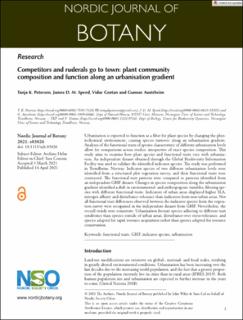| dc.contributor.author | Petersen, Tanja Kofod | |
| dc.contributor.author | Speed, James David Mervyn | |
| dc.contributor.author | Grøtan, Vidar | |
| dc.contributor.author | Austrheim, Gunnar | |
| dc.date.accessioned | 2024-01-15T09:22:03Z | |
| dc.date.available | 2024-01-15T09:22:03Z | |
| dc.date.created | 2021-11-23T10:10:13Z | |
| dc.date.issued | 2021 | |
| dc.identifier.citation | Nordic Journal of Botany (NJB). 2021, 39 (4), . | en_US |
| dc.identifier.issn | 0107-055X | |
| dc.identifier.uri | https://hdl.handle.net/11250/3111440 | |
| dc.description.abstract | Urbanisation is expected to function as a filter for plant species by changing the physiochemical environment, causing species turnover along an urbanisation gradient. Analyses of the functional traits of species characteristic of different urbanisation levels allow for comparisons across studies, irrespective of exact species composition. This study aims to examine how plant species and functional traits vary with urbanisation. An independent dataset obtained through the Global Biodiversity Information Facility was used to validate the identified indicator species. The study was performed in Trondheim, Norway. Indicator species of two different urbanisation levels were identified from a structured plot vegetation survey, and their functional traits were contrasted. The functional trait patterns were compared to patterns identified from an independent GBIF dataset. Changes in species composition along the urbanisation gradient identified a shift in environmental- and anthropogenic variables, filtering species with different functional traits. Indicators of urban areas displayed higher SLA, nitrogen affinity and disturbance tolerance than indicators from non-urban areas. Not all functional trait differences observed between the indicator species from the vegetation survey were recognised in the independent dataset from GBIF. Nevertheless, the overall trends were consistent. Urbanisation favours species adhering to different trait syndromes than species outside of urban areas; disturbance-over stress-tolerance, and species adapted for rapid resource acquisition rather than species adapted for resource conservation. | en_US |
| dc.language.iso | eng | en_US |
| dc.publisher | Wiley | en_US |
| dc.rights | Navngivelse 4.0 Internasjonal | * |
| dc.rights.uri | http://creativecommons.org/licenses/by/4.0/deed.no | * |
| dc.title | Competitors and ruderals go to town: plant community composition and function along an urbanisation gradient | en_US |
| dc.title.alternative | Competitors and ruderals go to town: plant community composition and function along an urbanisation gradient | en_US |
| dc.type | Journal article | en_US |
| dc.type | Peer reviewed | en_US |
| dc.description.version | publishedVersion | en_US |
| dc.source.pagenumber | 14 | en_US |
| dc.source.volume | 39 | en_US |
| dc.source.journal | Nordic Journal of Botany (NJB) | en_US |
| dc.source.issue | 4 | en_US |
| dc.identifier.doi | 10.1111/njb.03026 | |
| dc.identifier.cristin | 1957622 | |
| cristin.ispublished | true | |
| cristin.fulltext | original | |
| cristin.qualitycode | 1 | |

